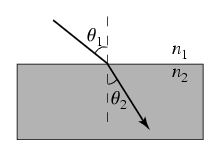| The Following Topics Might Appear on Quiz 3 |
| An interface is the boundary between media whose indices of refraction differ |
| Light only reflects or refracts (or both) at an interface |
| Refraction is the bending of light that occurs when it passes through an interface. |
| An object with a particular index of refraction becomes invisible when immersed in a fluid with the same index of refraction |
| In general, the denser the medium the higher its index of refraction. |
| When light passes through a medium, it must take time to interact with the molecules of the medium. |
| The denser the medium, the slower is the speed of light in it. |
| v = c/n, where v = speed of light in a medium, c = speed of light in vacuum, n = medium's index of refraction |
| Snell's Law: n1sin(θ1) = n2sin(θ2) |  |
|
| Total Internal Reflection is the reflection of a light beam at the interface between a dense medium and a less dense medium back into the dense medium from which it came |
Total Internal Reflection only occurs if the angle of the light beam relative to the line perpendicular to the interface is greater than θcritical=Arcsin(n2/n1)
n1 is the index of refraction of the denser medium from which the light beam originated |
| When light travels through an interface into a denser medium, it bends toward the line normal to the interface. (normal = perpendicular) |
| When light travels through an interface into a sparser medium, it bends away from the line normal to the interface. |
| The lowest index of refraction possible is 1, which is that of the vacuum |
| |
| Quiz will be: |
| closed book, closed notes. |
| 10 questions |
| 15 minutes long |
| totally multiple choice or T/F |
